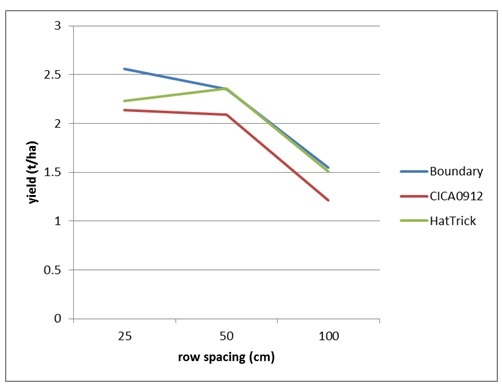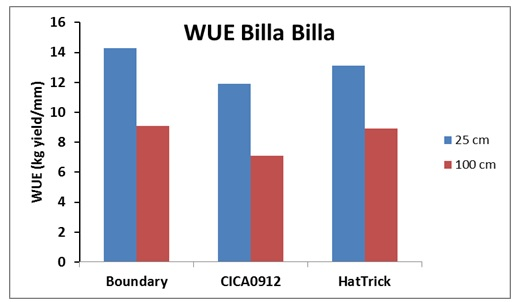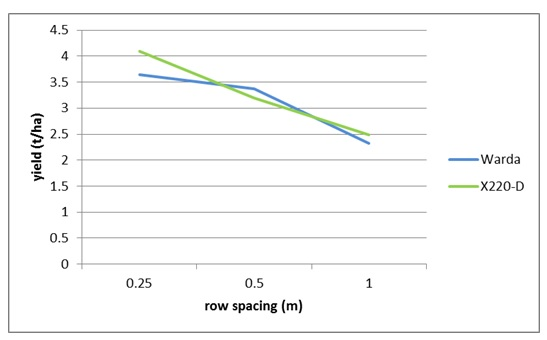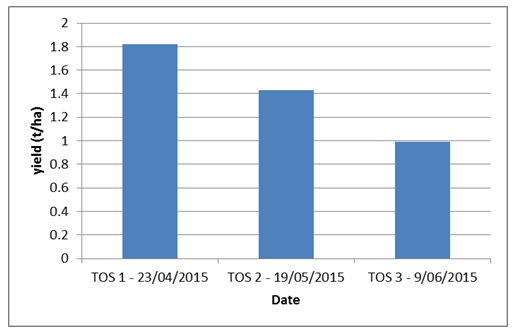Chickpea and faba bean agronomy ideal row spacing and populations
Author: Kerry McKenzie, Nikki Seymour and Howard Cox (Department of Agriculture, Fisheries and Forestry, Toowoomba), Bec Raymond (Department of Agriculture, Fisheries and Forestry, Goondiwindi), RCN Rachaputi (QAAFI, Kingaroy) | Date: 23 Jul 2015
Take home message
- Changes in agronomy can affect yield of pulses.
- In general increasing row spacing may decrease yield of chickpea and faba bean varieties, even in a dry season.
- Small plot chickpea yields of 4.7t/ha achieved.
- Faba bean yields to 5.5t/ha on narrow rows.
- Amount of nitrogen fixed reduces with wider row spacing.
Background and aims
Despite the potential environmental and economic benefits, the adoption of winter and summer pulse crops in the Queensland Grains Region is around 8% and 4% of total cropping area respectively, much less than what is required to keep grain cropping systems profitable in the long term. To increase the share of pulses in the total cropping area, strategies are required to enable growers to more consistently realise the potential productivity and profitability of pulse cultivars in their farming systems.
Winter pulses (chickpea and fababean) currently comprise approximately 8% of total cropped area in the Queensland Grains Region although the adoption varies from 5 to 12% depending on the growing region. Chickpea (Cicer arietinum) is the most adapted winter pulse crop in the Queensland with the area expanding to historically high levels in 2010. Seasonal yields of chickpea ranged from 0.5t/ha to 2t/ha depending on the timing and severity of biotic and abiotic stresses during the growing season. Although yields as high as 2.5t/ha have been achieved in varietal evaluation trials, the average yield during the 2008 – 2011 was approximately 1.2t/ha in the focus regions included in this project (Source: ABS statistics), suggesting a significant potential to increase productivity. A modest 10% increase in yield would result in a $20 to $25 increase in gross margin (based on a $200/ha gross margin). Over a winter pulse area of 125,000 ha, the increase in crop production would be valued at $2.5 to $3 million per annum.
Although the area sown to winter pulses in Queensland has increased over the last three years, there have been many challenges for growers with erratic seasonal conditions and a range of disease pressures on yield and quality. Growers’ attitude to pulse crops is also influenced by forecast prices relative to other cropping options including cotton and experiences from the previous season. The area of winter pulses in the region needs to be stabilised and the reliability of achieving seasonal yield potential improved.
The Pulse Agronomy project has consulted widely within the pulse industry to determine the priorities to be investigated throughout the term of the project.
Chickpea trials 2013/14
The trials have been based on 3 varieties, PBA HatTrick, PBA Boundary and CICA0912 an advanced breeding line, three row spacings (0.25m, 0.50m and 1.00m) and 3 or 4 plant densities (10, 20, 30 and 40plm2).
Over 2 years 6 trials have been planted on the Darling Downs and the Border rivers region. While these sites are not around Nindigully/ St George areas, the range of seasons and soil types suggests that results will be transferrable to such areas.
Row spacing results and discussion
In the first year of trials in 2013 at a high yielding site at Dalby the top yield was 4.7t/ha. This was delivered by the pre release line CICA0912 grown on a 25cm row spacing, this row spacing also provided the highest yield for the 2 commercial lines.
At the Billa Billa site the narrow row spacing of 25cm also produced the highest yield.
Table 1. Chickpea grain yields from 2 sites at different row spacings, 2013
|
Row Spacing (m) |
Dalby Grain Yield (t/ha) |
Billa Billa Grain Yield (t/ha) |
|
0.25 |
4.5 a |
1.9 a |
|---|---|---|
|
0.50 |
4.2 b |
1.8 b |
|
1.00 |
3.6 c |
1.6 c |
|
|
P < 0.001, LSD = 0.1375 |
P<0.005, LSD=0.3984 |
Both of these sites had limited in crop rainfall. The Dalby site had just under 130mm for the season however the majority of this was up till late July with a dry finish combined with high daytime temperatures meaning the crop grew mostly on stored moisture. The Billa Billa site received just under 60mm in crop and again had a hot dry finish. WUE at both sites were above what is considered the average for chickpeas, with figures of 13.2kg/mm/ha at Billa Billa and up to 17kg/mm/ha at Dalby.
In 2014 4 trial sites were established, again on the Downs and at Billa Billa with another site near Garah.
Billa Billa
The trial site was 40km NE of Goondiwindi on a well-structured, uniform deep to very deep, fine, self-mulching, cracking clay, grey vertosol and was planted into standing wheat stubble. The starting soil water content was 132mm in 120cm profile and the crop received 82mm of in-crop rain.
Results
There was no significant difference between cultivars at Billa Billa nor between 25 and 50cm rows (except for PBA Boundary), however there is difference when it comes to the 1.0m rows (Figure 1). From this trend it can be assumed that 1.0m row spacing is not optimal at this site.

Figure 1. The effect of row spacing and cultivar on yield at Billa Billa, winter 2014 (LSD (5%) = 0.323)
Water use efficiency
Water use efficiency is a valuable measure of the potential suitability of a crop especially in the northern grains region farming systems where rainfall can be limited and temperatures high. Values for chickpeas are usually in the range of 7 to 8 kg/ha/mm water used, at Billa Billa, above average water use efficiencies were achieved.
Narrow row-spacing produced the highest WUE and PBA Boundary produced a higher WUE but statistically it was the same as was achieved by PBA HatTrick (Figure 2). Effects of row spacing was significant with 25cm resulting in higher WUE (13.l kg/mm) compared to 8.4 kg/mm in 100cm rows. However, cultivar differences for WUE was not significant. A statistically higher result in all three cultivars in the 25cm spacing over 100cm.

Figure 2. The effect of row spacing and cultivar on water use efficiency at Billa Billa, winter 2014
(LSD 5% = 6.72)
Garah
The trial design was similar to the Billa Billa site, the chickpeas were planted into standing wheat stubble into a grey vertosol soil, with low planting moisture but opportunistic rain post planting.
Results
Overall, low to average yields were obtained at the Garah site but significant affects from the agronomic treatments were achieved (Figure 3). The lower yields were due to a very low starting moisture and low rainfall throughout the season.
The highest yielding treatments being all varieties on 25cm, were 66% greater than the lowest yielding treatment (varieties at 100cm). There was deemed to be no significant difference overall between the cultivars. With the row spacing trial the trend is indicating that narrower row spacings are achieving higher yields in all three cultivars.

Figure 3. The effect of row spacing and cultivar on yield at Garah, winter 2014 (LSD (5%) = 0.288)
The results for the Downs are in 2014 are not presented here, however the same trend is apparent with most varieties producing their best yields on the 25cm row spacing and lowest on 1m row spacings.
Plant population results and discussion
Across 2 years and 6 sites there has been no significant differences in grain yields from altering the plant population. In 2013 the treatments were 20, 30 and 40, and in 2014 an additional treatment of 10 plants/m2 was added. The results are almost flat across 20, 30 and 40 plants/m2, in 2014 there was a trend for lower yield at 10 plants/m2, however not statistically different.
The recommendation would be to continue to target the recommended planting rate to establish between 20 and 30 plants/m2. If there is poor establishment for whatever reason, while there will be a yield penalty at lower populations a replant may not be necessary until the population is below 10 plants/m2 (assuming a uniform distribution).
Faba bean trials 2014
2014 was the first year that any faba beans trials were included in the project and 3 sites were established. Two sites tested similar row spacings to chickpeas (25, 50, 100cm) at Dalby and Garah, with a time of sowing trial at Dalby.
Garah
The trial design consisted of 3 varieties Cairo, PBA Warda and a pre-release line X220-D grown at 3 row spacings (0.25m, 0.5m, and 1.00m) with a targeted density of 25 plants/m2. The trial was planted on grey vertosol which had been on a long fallow prior to planting. The crop received 96mm of in crop rain.
Results
Overall, above average yields were obtained at the Garah site and significant effects of the agronomic treatments. The highest yielding treatment was 60% greater than the lowest yielding treatment. There was deemed to be no significant difference overall between the cultivars PBA Warda and Cairo however the breeding line X220-D performed significantly better than the other two varieties (Table 2).
Table 2. Effect of cultivar on yield, Garah (LSD = 0.482, P=0.05)
|
Cultivar |
Grain yield (t/ha) |
|
PBA Warda |
4.41 |
|---|---|
|
Cairo |
4.09 |
|
X220-D |
4.94 |
The narrow row spacing of 0.25m has significantly out yielded other spacings at 5.51t/ha (Table 3). X220-D was significantly higher yielding than the other two cultivars at 0.25m and at 0.5m while there was no significant difference between the 1.0m treatment.
|
Row Spacing (cm) |
Mean Yield (t/ha) |
|
25 |
5.51 |
|---|---|
|
50 |
4.95 |
|
100 |
3.25 |
Table 3. Effect of row spacing on yield, Garah (LSD = 0.513, P=0.05)
Similar to the Warra site, the same trend can be found when comparing the effect of row spacing and cultivar on yield, narrower rows are gaining the highest yields (Figure 4). The pre-release variety, X220-D yielded 20% greater in the 0.25m and 0.5m treatments than both PBA Warda and Cairo.

Figure 4. Effect of row spacing and cultivar on yield of faba bean, Garah, winter 2014 (LSD 5% = 0.84)
Warra
The trial design consisted of 2 varieties PBA Warda and X220D (a pre-release line) grown in 3 row spacing (0.25m, 0.5m, and 1.00m) at a density of 30 plants/m2. The soil type is a grey cracking clay vertosol and the trial was planted on an available water content of 140mm in 0- 120cm profile. The crop received 113mm rainfall during the season.
Results
Overall, there was no significant difference between the two cultivars (Table 4) however the breeding line X220-D achieved marginally better yields than PBA Warda. However, significant effects of the agronomic treatments were observed with both varieties responding positively to decreasing row spacing.
Table 4. Effect of cultivar on yield, Warra, winter 2014 (LSD = 0.4915, P=0.05)
|
Cultivar |
Grain yield (t/ha) |
|
PBA Warda |
3.081 |
|---|---|
|
X220-D |
3.252 |
When comparing the row spacing there is a trend indicating that narrower rows are producing higher yields. There is significant difference in yield between the 0.25m and 0.5m spacing as well as the 1.0m treatment (Figure 5). However, the yield response of the pre-release line X220-D to decreasing row spacing was consistent whereas the yield increment between 0.50m and 0.25m was marginal for PBA Warda.

Figure 5. Effect of row spacing on yield of two faba bean varieties, Warra, winter 2014
(LSD 5% = 0.52)
Effect of time of sowing on yield of faba bean
This preliminary trial was planted and managed by Glenn Milne near Dalby. The variety PBA Warda was planted into standing corn stubble on a well-structured, uniform deep to very deep, fine, self-mulching, cracking clay, with a targeted plant population of 25plants/m2 on 32cm row spacing and there were three times of sowing:
- 23 April 2014
- 19 May 2014
- 9 June 2014
There was a linear reduction in yields as the planting time delayed beyond 23 April (Fig 3). However, there was no significant difference in yield between the first and second dates nor the second and third dates but there is between the first and third dates. The first planting date (23 April) had the highest yield at 1.82t/ha, followed by the second date at 1.43t/ha and then the latest at only 0.99t/ha. This trend indicates that there is a need to investigate earlier dates of sowing with more varieties for the Southern Downs region for achieving higher yields.

Figure 6. Effect of time of planting on yield of faba bean, Dalby, 2014 winter (LSD = 0.593, P=0.05)
Nitrogen fixation
In the 2013 season the effect of row spacing on the amount of nitrogen fixed was tested in the chickpea trials. There were no differences in N fixation amongst varieties but row spacing significantly decreased %Ndfa (nitrogen derived from the atmosphere) and total amount of N fixed, particularly at the Dalby site (Table 5).
The net N balance for each of the sites also showed a significant impact of row spacing and of the site. Up to 59 kg N/ha remained at the Dalby site when chickpeas were grown on 0.25m rows but only 23 kg N/ha from the 1.0 m row spacing. At Goondiwindi, the net N balance ranged from 6 down to -6.4 kg N/ha as row spacing increased from 0.25m to 1.0m. Our values were similar to those measured by Schwenke et al. (1998) who found lower N fixation in chickpeas in the drier year (1994) of their survey of commercial crops in northern NSW. As a crops’ demand for N increased so did the N fixation by that crop as seen at our Dalby trial grown under better seasonal conditions. However, the row spacing effect cannot simply be explained by higher plant N demand as all crops were at the same plant population density of 30 plants/m2. On-going trial work in 2014 will examine links of N fixation with changes in other agronomic factors (eg. soil temperatures and water use efficiencies) due to different row spacing.
Table 5. Reduction in N fixation and total amount of N fixed in chickpea (meaned across 3 genotypes) as row spacing in the field increases
|
Row Spacing (m) |
% Ndfa |
Total Crop N Fixed (kg/ha) |
||
|
Dalby |
Billa Billa |
Dalby |
Billa Billa |
|
|---|---|---|---|---|
|
0.25 |
61.0 a |
39.2 |
187.3 a |
62.8 a |
|
0.5 |
55.8 a |
36.1 |
161.9 a |
48.0 ab |
|
1.0 |
47.6 b |
36.3 |
122.5 b |
42.0 b |
|
LSD (P=0.05) |
7.0 |
n.s |
31.5 |
16.3 |
Summary and conclusion
- Narrow row spacing (25cm) consistently yield higher than wider row spacings (75cm and above) for both chickpeas and faba beans.
- This effect has been seen across 2 years and differing seasons and environments.
- Row spacing has a larger effect on yield than plant population.
- Earlier planting of faba beans is best to maximise yields, however further trials are required to determine what is too early.
References
Schwenke GD, Peoples MB, Turner GL and Herridge DF (1998) Does nitrogen fixation of commercial, dryland chickpea and faba bean crops in north-west New South Wales maintain or enhance soil nitrogen? Australian Journal of Experimental Agriculture 38, 61-70.
Acknowledgements
Many thanks to supporters of the trials from Stephen Krosch, Katrina Conway, James McLean, trial co-operators Glenn Milne, Wade Bidstrup, Ben Moloney and the Woods Family.
The research undertaken as part of this project is made possible by the significant contributions of growers through both trial cooperation and the support of the GRDC, the author would like to thank them for their continued support.”
Contact details
Kerry McKenzie
Department of Agriculture, Fisheries and Forestry Queensland
0477 723 713
kerry.mckenzie@daff.qld.gov.au
GRDC Project Code: UQ00067,
Was this page helpful?
YOUR FEEDBACK
